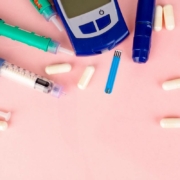The Difference Between Type 1 and Type 2 Diabetes
Even though both Type 1 and Type 2 diabetes are associated with elevations in blood glucose, there are some distinct differences between the two disorders. These differences include the following:
Overview
Only 8 percent have Type 1 diabetes and all the rest have Type 2 diabetes. Type 1 diabetes is 10 times less common than Type 2 diabetes. Type 1 diabetes is caused by the body’s immune system damaging the pancreas and, therefore, no insulin can be manufactured by the body. In Type 1 diabetes, the body fails to make insulin.
In Type 2 diabetes, the body either develops a resistance to insulin or not enough insulin is produced to lower the blood sugars. To date, except for family history, there are no known risk factors for Type 1 diabetes. On the other hand, known risk factors for Type 2 diabetes include advancing age, family history, obesity, use of certain medications, sedentary lifestyle, and ethnicity.
By reducing the risk factors, Type 2 diabetes can be prevented or its symptoms reduced.
Symptoms of Type 1 and Type 2 Diabetes
The majority of people who develop Type 1 diabetes will be on the thinner side. It is extremely rare to meet a Type 1 diabetic who is overweight. On the other hand, the majority of people with Type 2 diabetes will be overweight. The high-fat content in the body also plays a major role in developing insulin resistance.
Type 1 diabetes usually presents with symptoms much earlier in life. In most cases, the diagnosis of Type 1 diabetes will be made between ages two and fifteen. Whereas the majority of Type 2 diabetes cases present when the individual is over 50 years of age. The symptoms in Type 1 diabetes generally present suddenly. The individual may present with a sudden fever, severe dehydration, frequent urination, ketones in the urine, or even be in a coma, and medical tests will reveal a lack of insulin in the body.
However, with Type 2 diabetes, the symptoms may be vague, and the diagnosis can be delayed for a few months. Some individuals may develop a milder form of diabetes, called prediabetes, a few months or years before developing the full onset of Type 2 diabetes.
Treatment for Type 1 and Type 2 Diabetes
Type 1 diabetes has only one treatment: insulin replacement. There is no other treatment for Type 1 diabetes and without insulin, death is very likely. Whereas Type 2 diabetes can be managed with diet, weight loss, medications, and/or insulin. Individuals with Type 1 diabetes tend to develop a life-threatening condition called diabetic ketoacidosis.
This condition is chiefly due to the lack of insulin. On the other hand, Type 2 diabetics tend to develop a condition called a hyperosmolar coma, which is chiefly due to the high levels of glucose in the bloodstream. There is no cure for Type 1 diabetes and insulin treatment is required for life; on the other hand, with lifestyle changes, the symptoms of Type 2 diabetes can be reduced or even completely eliminated.
Diabetes Can Be Managed, With Proper Care
Irrespective of the differences between Type 1 and Type 2 diabetes, all individuals with diabetes must follow up closely with their primary care provider. Diabetes is not a benign illness and can result in devastating complications that can result in loss of vision, kidneys, limbs, heart attacks, stroke, and even premature death if not treated appropriately. The key is to take steps to maintain healthy blood sugar levels every day.
Cano Health has been specializing in Type 1 and Type 2 diabetes care management for years and knows exactly how to apply that to senior care as well. Contact us today for more information about how to better live with the disease and manage it so you can live well.









